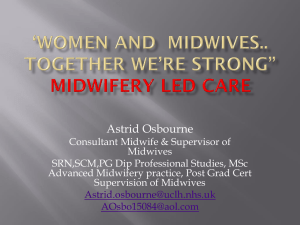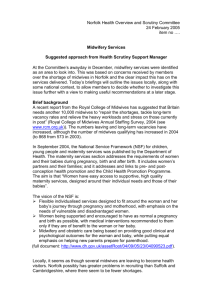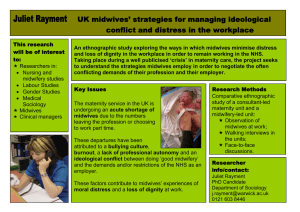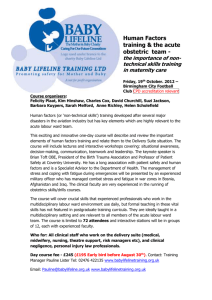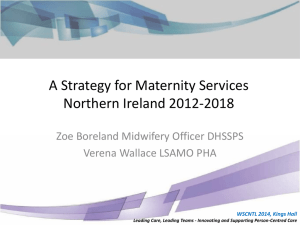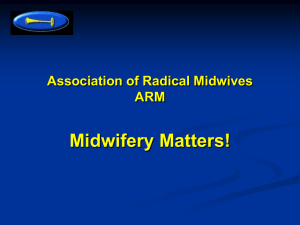Final Report - County Durham and Darlington NHS Foundation Trust
advertisement
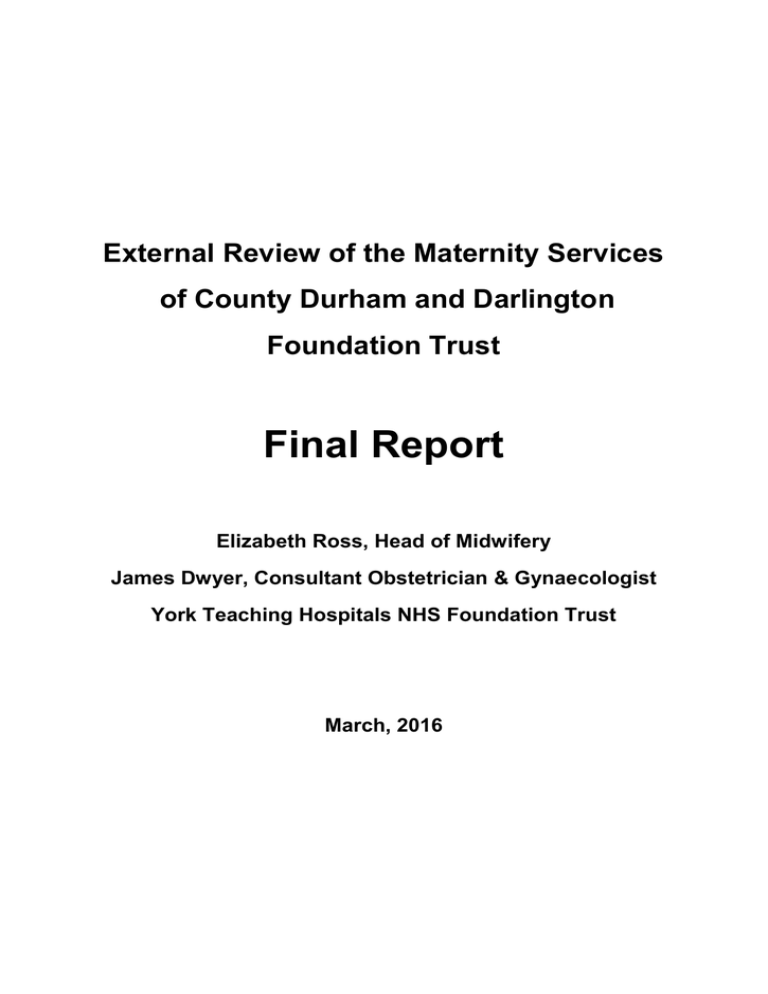
External Review of the Maternity Services of County Durham and Darlington Foundation Trust Final Report Elizabeth Ross, Head of Midwifery James Dwyer, Consultant Obstetrician & Gynaecologist York Teaching Hospitals NHS Foundation Trust March, 2016 Description of Maternity Services at County Durham and Darlington NHS Foundation Trust In 2002, the Acute NHS Trusts based at Darlington and Durham merged to become a single Trust with the 2 main hospitals 24 miles apart along the main A1 route. Maternity services were provided at 3 hospital sites until 2013 when Bishop Auckland Hospital was closed for births, leaving the 2 main sites at University Hospital of North Durham (UHND) and Darlington Memorial Hospital (DMH). Although the sites are 24 miles apart, their geographical position means that referral pathways vary, with UHND referring north towards Newcastle, and DMH eastwards towards Middlesbrough. There is also mixed urban and rural populations leading to a variety of challenges for the community services. In 2014 there were 5455 births with 3228 at UHND and 2227 at DMH. The department is part of the Care Closer to Home Clinical Care Group which also includes Child Health and Community Services. Currently, this is changing so that the Clinical Care Group will constitute Women's and Children's Health. The department is led by the Clinical Director (CD) and Head of Midwifery (HoM). Both sites have separate medical staffing, each having nominated consultants for the labour ward lead. The CD is clinically based at DMH and attends both sites in the CD role. The HoM is based on both sites. The HoM manages the community and outpatient maternity matron, the acting senior midwife at UHND and the acting senior midwife at DMH, as well as three specialist midwives (two covering Safety and Quality, and one covering Safeguarding). Final Report – Page 1 On the UHND site, there are 12 consultants, 11 of whom undertake labour ward duties, with 4 covering resident night shifts. At DMH, there are 10 consultants, all of whom undertake labour ward duties, and with 4 covering resident night shifts. The clinical teams at each site are managed independently of each other. Reason for the maternity review We were contacted by Professor Christopher Gray, Medical Director at CDDFT, following discussions between the Trust and the 3 local CCGs (North Durham; Durham Dales, Easington and Sedgefield; and Darlington). There were concerns raised over interpersonal behaviours, a series or serious incidents and never events, and the processes for following clinical guidelines. The Terms of Reference for this report are attached in Appendix 1. We undertook a structured visit, with a full day on each site, meeting with different staff groups for discussions around any concerns they had about the function and safety of the department. The focus groups included Healthcare Assistants (HCAs), Midwifery Care Assistants (MCAs), midwives (bands 5,6,7), senior midwives and consultant medical staff. A meeting with the Director of Nursing summarised the clinical cases of concern. Staff had the opportunity to also put comments in a sealed box that would be available to us and they could send a confidential email which would be treated in the same manner. We met with 82 members of staff over the 2 days and received 137 anonymised comments (summarised in appendix 2). Final Report – Page 2 Further documentation was provided from the trust via secure emails. These are listed in Appendix 3. We will discuss previous reports that have been undertaken to assess the service, and our interpretation of the changes that have happened, and then describe the findings from our review. Positive Feedback from staff It is important to emphasise early on in this report that during the staff engagement meetings and from the comments received, staff were proud of many areas of the service UNICEF Baby Friendly Initiative, full accreditation with an increase in breast feeding initiation rates and good peer support in place. Maternity Support Worker (MSW) role has a positive impact and is valued. Royal College of Midwives (RCM) award for increasing skills of MSW RCM award for transitional care with paediatrics Enhanced recovery for Elective Caesarean Sections Good mandatory training in house and community scenario based training. Resident consultant O&G role. All Band 7's have Neonatal Life Support training. Good achievement of 1:1 care on Labour Ward Safety and Quality midwife roles provide good risk management support for all staff groups. Final Report – Page 3 Good Friends and Family qualitative feedback with good rates of feedback achieved. Implementation of 'Baby Clear' with resulting decrease of rates of smoking in pregnancy. Maternity Review, 2009 A review of the service had already taken place in October, 2009 by Julie Scarfe (HoM, Leeds) and James Walker (Professor of Obstetrics & Gynaecology, Leeds) which had been undertaken for similar concerns. Their recommendations are contained in Appendix 4. There has been progress made with some recommendations from this report. However the review outlines issues which remain unresolved regarding leadership, relationships and poor behaviours, particularly at DMH. Leadership on the Labour Wards was highlighted as an issue in the report. Whilst changes are in place with a clinical lead and a senior midwife on each site, the specific Labour Ward Midwifery leadership remains unresolved. Safer Childbirth 2007 recommends one whole time equivalent manager for each Labour Ward. The senior midwives at Band 8a are not dedicated to the Labour Ward as they cover the service on each hospital site. The skill mix on each Labour Ward also remains an issue detailed further under maternity workforce. The number of Community Team Leaders (Band 7) was commented on as being too high in the report. This may have changed following the review 6 years ago, however Final Report – Page 4 the number of Band 7 managers in Community services (5 Community Team Leaders) does appear higher than expected (with each aiming for 3 days management time each week). Response to the Morecambe Bay Investigation (May 2015) This report is a self-assessment against the Morecambe Bay report. It is comprehensive and demonstrates good insight into Maternity services at CDDFT including achievements and identification of issues with actions to improve. Achievements include increasing consultant presence on the Labour Wards, introduction of the Maternity Early Warning Score and the sepsis care bundle. These achievements were recognised by the staff we spoke to with the increased consultant presence on the Labour Ward regarded very positively. The report recognises issues resulting from poor working relationships and behaviours impacting on the whole team, and having the potential to impact on the quality and safety of care; Tensions between paediatrics and maternity, described as a 'them and us' culture. A long history of poor consultant behaviours being tolerated. Some staff, mainly consultants, persistently refusing to follow guidelines as they ‘don't agree with them'. This is more prevalent at DMH (e.g. Induction of Labour, WHO theatre checklist, and Premature rupture of membranes) Final Report – Page 5 It is disappointing to read that a number of the consultants were unable to attend the Insights training from October, 2014 to January, 2015. This training was put in place following reports of bullying behaviour amongst staff at all levels and complaints in relation to staff attitudes and behaviours. CDDFT are not an outlier for stillbirth, neonatal deaths or maternal deaths. Themes from case review of stillbirths and neonatal deaths are identified in the report as; CTG classification Escalation of care Communication We were informed that CDDFT do have training in place to address CTG classification and interpretation. Communication and escalation of care could be improved with the use of clear and accepted guidelines and by developing a supportive culture clinically. It is recognised there is clear reporting of incidents in the report, however many staff at DMH told us they are afraid to raise concerns. This is concerning and reflects the view of the current culture at DMH. Concerns regarding neonatal resuscitation skills and competence is recognised in the report and identified in a number of the RCA and SI reports that were shared with us. Overall the report states 'the view of staff working within maternity services is that it is a safe service and staff are very proud of the quality of care they provide. Final Report – Page 6 However, there are issues around interpersonal relationships within teams that require action.' This view was reflected to us in staff engagement meetings during visits and through comments received. Recommendation: Audit the implementation of the action plan of the response to the Morecambe Bay report. Saving Lives, Improving Mothers Care 2014 (Care Closer to Home) This document is a multidisciplinary self-assessment against the Saving Lives report. It is a good response report and outlines plans including the management of sepsis and the deteriorating patient (implementation of the Maternity Early Warning Score). There is a good uptake (61%) of the flu vaccine at booking. MBRRACE-UK perinatal mortality report: 2013 births. This reports assessed stillbirths and neonatal deaths at CDDFT for 2013. In comparison to other similar trusts and health boards, the rate of stillbirth was up to 10% higher, the rate of neonatal death up to 10% lower and the rate of extended perinatal death up to 10% higher. Final Report – Page 7 Classification is either up to 10% higher (or lower) or more than 10% higher (or lower). The results for 2013 suggest that the rate of perinatal loss does not represent a concern. Friends and Family Test There is good feedback from women through the Friends and Family Test (FFT) responses. Overall, there is an above 90% rate for those likely or extremely likely to recommend the service. For those who are unlikely or extremely unlikely to, there were only 4 out of almost 2000 respondents for the months assessed. This would indicate that the service is well thought of by users. The Safety and Quality midwives display feedback for staff, however a number of staff told us they do not receive qualitative feedback from the FFT. Workforce - Senior Medical Staff Meetings were undertaken on both sites, with around 6 to 7 consultants present at each meeting. There were some themes that were discussed on both sites. This included the perceived separation between the senior clinical staff and the management team. The clinicians felt that their clinical voice was not listened to when concerns were raised, such as when a reduction in the level of administrative staff cover occurred. Concern was also raised about the electronic care record, especially when there was a failure in IT so that the record was not available for Final Report – Page 8 clinical appointments. It was viewed that some audits and clinical outcomes were reviewed without appropriate clinician input and that significant decisions were made based around these. Also, with the loss of the medical staffing department, it was proving difficult to be proactive in booking junior medical grade locums. The Edgecombe review was brought on relatively quickly from the time the consultants were informed, and their assumption is that they were the last to know about what was happening. Concerns were expressed about how the decision was made as to who would undergo the review as this was not universal and was not explained to those involved. Even so, most consultants expressed a view that they were hoping some positive changes would come about from this. Job planning was brought up on both sites as a concern, in that the process of agreeing a job plan was never undertaken prospectively. Their view was that there were too many steps involved in getting a job plan signed off so that it was inevitable they would always be retrospective. Both sites commented that their view was of good relationships with the other maternity staff, particularly the midwifery staff. In relation to the Darlington site, concern was expressed about the area used for important multi-disciplinary handover of care on the labour ward, as it is currently the kitchen area. For Durham, a significant issue was the clinical leadership cover for that site, as the CD is mainly based at Darlington and attends about once a week. Previously, there Final Report – Page 9 was a clinical lead based at this site but this was changed a few years ago without open discussion with the consultants. Because of this, they see Darlington as being the main site for senior management. However, they see the benefit of cross-site meetings including joint guideline development. The discussion was around the concern that there doesn’t appear to be a plan in place about how their timetable, including oncall, will be planned moving forward. Overall, there was a general consensus from both sites that a single maternity unit would prove significantly difficult to manage safely because of the referral pathways involved with other organisations. Some felt that this issue has never been resolved and this leaves the staff in an unsettled situation. From other staff group meetings, some discussions focussed on how the consultants worked. The view on the Durham site was that overall the consultants worked well and in a multi-disciplinary manner. This was also the view at Darlington for the majority of consultants but specific consultants were named as having a potentially disruptive nature to the running of the unit. Specifically, consultants were mentioned where their interaction was thought to be unproductive and it was viewed that this could impact on patient care. Both Labour Wards have joint clinical leads. At Durham, it was expressed that they worked well together and brought about active change in combination with the midwifery staff. This was not the situation at the Darlington site where change appeared to be minimal. Workforce - Midwifery and support staff Final Report – Page 10 The midwifery staffing ratios per births provided to us are good on each site and as a whole Trust. The Head of Midwifery told us the midwifery staffing ratios meet national recommendations; however it did not feel this way operationally. She felt there were issues affecting the staffing ratios at present including staff sickness, midwives on supervised practise programmes, the acuity of women, transitional care for babies (‘it feels busier’) and the skill mix of staff affecting the workload. Feedback from all staff groups including senior midwifery staff and consultants reflected the Head of Midwifery concerns regarding staffing. In particular the effect of; Poor skill mix on Labour Ward. This was felt to be due to an increase in Band 5 midwives and community midwives rostered to work regularly on Labour Ward (requiring support in this high risk area). This puts additional pressure on the Band 7 and 6 Midwives. Labour Ward Co-ordinators are not supernumerary on both sites which has an impact on leadership and support provided to staff. Community midwives working regular hours on the Labour Ward has an effect on continuation of care for their own caseloads and safeguarding cases. Community caseloads are higher than nationally recommended levels, however it is recognised there are Maternity Care Assistants working in Community who provide valuable support to the midwives role and release midwifery time to provide care. Final Report – Page 11 Transitional care of babies is undertaken without adequate resource and support from paediatrics. The number of Band 7 managers in Community services (5 Community Team Leaders and a Matron) does appear higher than expected (each Band 7 aiming for 3 management days per week). The Community midwives told us the on call midwife rota for Labour Ward had a positive effect on the amount of time they were called out. There is real appreciation for the Maternity Care Assistants and the positive impact of the care they are able to provide. Both Labour Wards undertake the Birthrate Plus acuity tool but there are no reports generated from this. Reporting of this would help inform senior staff in decision making and future workforce planning. The Labour Wards do not have a dedicated Midwifery Labour Ward manager (as recommended in Safer Childbirth 2007). A senior midwife Band 8a is allocated to each site although they are not dedicated to the Labour Ward. Labour Ward Co-ordinators are allocated management days to provide operational management (2 to 3 management days each per week). This seems a lot of management time spread amongst many people with negative comments around this received in staff engagement meetings and from anonymous comments. There were a number of comments received regarding the roster and effect on staff of working days and nights in one week. The implementation of an on-call rota for Final Report – Page 12 Labour Ward also received a significant number of negative comments from midwives involved in the roster (but positive comments from Community midwives). Recommendations: To review the midwifery skill mix on each Labour Ward; o To have experienced and skilled band 6 core Labour Ward midwives on every shift with a Labour Ward Co-ordinator. o Reconsider the current model of Community Midwives regularly working on the Labour Wards. o Consider the possibility of utilising theatre staff for scrub roles. To have one whole time equivalent Labour Ward manager on each site (as recommended in Safer Childbirth 2007). This will reduce the need for allocated management days for the Labour Ward co-ordinators thus releasing time to increase senior midwifery clinical presence, increased skilled staff and support to the Labour Wards. To work towards the Labour Ward Co-ordinator to be supernumerary to provide guidance and support to midwives and medical staff. Where this is not possible (in peaks of activity and shortfalls in staffing) the Labour Ward Co-ordinator should avoid providing care for women in established labour (to enable them to respond quickly to Labour Ward emergencies and provide advice and guidance). Use Birthrate plus Labour Ward acuity data to help inform midwifery workforce planning. Final Report – Page 13 To review the level of support provided from the Neonatal Unit for transitional care babies (this was a repeated issue and risk raised by staff on both sites). Review Band 7 roles in Community services, to enable optimum utilisation of resources to achieve a reduction in community caseloads without loss of actual management time. Review administration support to release clinical staff time to provide care. Supervisors of Midwives The purpose of supervision of midwives is to protect women and babies by actively promoting safe standards of midwifery practice. Supervision is currently a statutory responsibility that provides a mechanism for support and guidance to every midwife practising in the UK. This role is carried out by Local Supervising Authorities (LSA) We spoke to some supervisors of midwives during the visits and received positive comments from staff regarding the support they provide. The LSA had undertaken an audit visit of the Supervisors of midwives at CDDFT on 5 August 2015. A draft report was shared with us. The report is positive with good initiatives e.g. 'pats on back' which has been well received by midwives. Challenges were identified around time to effectively deliver the function and delineation of the role (between substantive role and supervisor of midwives role). The assessment found CDDFT Supervisors of Midwives to be fully compliant in all rules and standards on the day of the audit visit. This is very good. Final Report – Page 14 Whilst this role is undergoing changes to the regulation aspect and statutory function, the support, guidance and positive impact on patient safety cannot be underestimated. This is reflected in comments from staff in the LSA report and in comments received during our visits. The role will also be valuable in supporting midwives through revalidation due to commence in April 2016. Risk Management The Obstetrics and Gynaecology Risk Management Operational Policy (January 2015) outlines the process for management of risk and clinical governance in Maternity services including leadership and accountability arrangements. This includes the process and management of the risk register, guidelines, incidents, serious incidents, claims, complaints and response to national reports. It states that staffing is monitored and the escalation policy provides guidance for staff to follow. It may be helpful to use reports from the Birthrate Plus acuity tools on the Labour Wards to aid in the monitoring and workforce planning. The document provided to us 'Overview of clinical risk in Obstetrics and Gynaecology in the Care Closer to Home' provides a good analysis of risk and identifies areas of concerns such as Newborn Life Support skills and competence amongst paediatricians, and difficulties embedding learning from retained swab never events. There is good response seen at DMH to complaints around attitude and communication in providing customer care, human factors and Insights training for staff. Final Report – Page 15 There is a higher readmission rate of infants under 28 days of age at Durham site (78 compared with 18 at Darlington). On discussion with staff they felt this was due to the introduction of NICE guidelines in management of neonatal jaundice. If this is the case then this poses a question of why the same increase in readmissions has not been seen at DMH if the same application of NICE guidance is in place. Incident reporting is good and staff told us they were aware of changes following incidents; however the report states reporting is lower at DMH. This is reflective of staff feedback during staff engagement meetings and comments received around behaviours and culture at DMH (described under behaviours section). At DMH staff reported feeling fearful and unsupported when discussing and reporting incidents. A 'blame culture' was described at DMH by a number of staff from different groups, having a negative effect on individuals. The Trust achieved level 2 CNST (Clinical Negligence Scheme for Trusts) standards in February 2014. On DMH site staff expressed they would like to be involved in discussions following incidents and be able to see the final reports (especially when they have been involved in writing a statement for a case). Actions only from reports are shared with staff which does not provide full understanding of the reasons for actions. The safety and quality midwife informed us of a plan to commence regional risk management meetings. This is good practise to share learning. There was good feedback in staff meetings regarding the role of the safety and quality midwives on each site. Final Report – Page 16 Audit There is a regular cycle of audit undertaken within the department. This occurs quarterly and covers varying aspects of obstetrics and gynaecology. The meeting is minuted with an attendance register, including apologies. The audit projects are presented by use of a PowerPoint presentation which is then stored on the minutes of the meeting. This includes a summary of the results with RAG ratings, if appropriate, and any required actions along with the persons responsible for them. The maternity areas covered recently include Post-partum haemorrhage Vaginal birth after Caesarean WHO theatre checklist Venous thrombo-embolism Enhanced recovery PET protocol Fetal blood sampling Operative delivery documentation Consent 3rd/4th degree tears Perinatal meetings Final Report – Page 17 At DMH, these are held on a monthly basis. The meetings are minutes with an attendance list. Both O+G and paediatric staff are in attendance. Perinatal mortality and morbidity cases are discussed with the use of PowerPoint presentations. A summary is written along with learning outcomes. At UHND, the meetings are every 2 months. As with DMH, minutes are produced containing the attendance list, summary of action and learning outcomes. On both sites, the meetings appear well attended by senior and junior medical staff but only a small number of midwives are in attendance. This may be related to the timing of the meetings not being good for the time when midwives are more likely to be free. Discussions between senior medical and midwifery staff would be useful to explore when the best time might be for both staff groups to attend. This would offer the advantage of open, multi-disciplinary discussions around cases. Serious Incidents We were given access to a summary of the cases where a concern had been investigated in relation to maternity and/or neonatal care. The neonatal cases will be reviewed by Dr Chris Day and Denise Evans. 15 incident reports (9 RCA short reviews and 6 SIs) were reviewed in all; Final Report – Page 18 There is evidence in the reports of good multi-disciplinary team (MDT) involvement in the case discussion and root cause analysis meetings which appear to have identified main areas of concern. The main themes from the above RCA's and SI's were around; Communication Documentation Clinical care provided by Midwives, Obstetricians and Paediatricians CTG use and interpretation in a number of cases Recommendations: Review of midwifery skill mix on Labour Ward and the supernumerary role of the Labour Ward Coordinator. The policy for swab and instrument counts should be clarified to ensure it is the same on both sites and in all relevant departments. Provide staff access cross site to all serious incident and RCA reports. This will help staff to appreciate the full picture and reason for recommendations, stimulate discussion and aid learning from incidents. Follow up of the action plans from these SI’s and RCAs including actions taken with midwives and medical staff following incidents. Behaviours Final Report – Page 19 During staff engagement meetings and from written comments received, there are significant concerns regarding the behaviours of some staff and the negative effect this has on the safety of mothers and babies and on staff themselves. Consultants at DMH Relationships between members of staff at DMH were said by many to impact negatively on the service. We were told about 'very heated disagreements' taking place, stating Consultants will override another consultant’s decision and plan of care; 'it's not a safe culture' which has the potential to impact on patient safety. The interaction between certain specific consultants is thought to be unproductive and viewed that this could also impact on patient care. Difficult behaviours seem to have been tolerated and not addressed for years, mainly at Darlington. There were comments regarding issues of bullying by some of the Band 6 and 7 staff which has a negative impact on others, increasing sickness and stress at work. The impact of this type of behaviour and culture poses a risk to patient care. Describing individuals as 'passionate' and 'strong characters' is not an excuse for poor behaviour. We were told that some senior staff (midwives and medical staff) were not approachable. Staff said they sometimes felt 'in fear of discussing cases with senior medical staff' and described a lack of respect and distrust between midwives and medical staff and 'poor morale' at DMH. Final Report – Page 20 When questioned further about 'poor morale' we were told there is a 'blame culture’, with finger pointing and criticism, resulting in staff reluctance in escalating concerns and discussing risk issues. We were told by senior midwives that the Consultants seem to have no awareness of the effect their behaviour has on those around them. They get a different reception depending on which consultant they call, and stated there were incidents regarding this. We were told that there has been some conflict management training and 'Insights' training, bullying and harassment (theatre style) workshops with some improvement seen in the staff survey. It was commented that not all Consultants were able to attend this training. Recommendation: Implement the RCOG and RCM information and training resources on undermining behaviours. The CD and HoM to take a firm stance on not tolerating these behaviours in anyone and encourage staff to report any undermining behaviour. Environment and equipment We received a significant number of negative comments at DMH regarding the environment, particularly the lack of suitable space for handover on Labour Ward (currently in a kitchen). Final Report – Page 21 The removal of the staff room has been the cause of bad feeling amongst staff with comments regarding not feeling valued which contributes to low morale. A number of comments received were around access to computers and lack of equipment with staff saying they spend time looking for equipment taking them away from patient care. We were asked if the service is safe Senior staff and individuals feel the standard of care is good and the service is safe. There is a risk identified as staff expressed feeling worried about raising concerns or escalating clinical concerns due to the impact of senior staff behaviours. Reluctance to escalate to the 3rd on call was identified. We were of the opinion that overall, the maternity service is safe and that many of the potential risk areas have already been identified. However, it is important to recognise that senior staff behaviours have the ability to erode this safety net and could lead to a serious risk of poor clinical outcomes if they are not formally addressed. For the senior medical staff, the Edgecombe review should provide clarity on how to change individual behaviours in the interests of the whole department. Of note is that the staff were very keen to engage with us which provides us with reassurance about how the department can develop. The recommendations for the provision of senior leadership should provide a stable environment to allow the safety culture to develop further, and by involving staff at all Final Report – Page 22 levels in investigations and subsequent recommendations, they should feel that their individual voices are being listened to. It is important for the very senior management team to appreciate the concern staff have with regard to possible reconfiguration onto a single site. Unless this is being planned in the short or medium term, some level of stability can be provided by allowing the department to develop with this in mind. Final Report – Page 23 Summary of recommendations: 1. It is recognised that the Clinical Director is acting in an interim position, following the previous CD stepping down from the role. A permanent fixed-term position should be appointed, to provide stability for the directorate. 2. There should be a Deputy Clinical Director / Clinical Lead on the opposite site to where the Clinical Director undertakes their normal clinical duties. This allows for much of the operational issues to be resolved with the knowledge and understanding of the day to day workings of the site. It also identifies a visible member of staff who can be approached if concerns are noted. Currently, it is challenging for the Clinical Director to understand the detailed working practices of both sites, as they are mainly based on one site. 3. The directorate is moving from the Care Closer to Home Clinical Care Group to a more focussed Women’s and Children’s. This should allow the trust’s senior management team to have a better understanding of the issues and challenges facing the directorate. However, it is important that the outcomes are continually reviewed to ensure this occurs. 4. There are senior midwifery posts that are still not permanent, even though the appointments were some time ago. The directorate should decide which posts it wishes to keep and make these permanent. This will offer stability within the midwifery workforce over both sites. 5. There should be a discussion at directorate level over the roles and accountability for the Labour Ward consultant leads. The roles appear to function well on the Durham site but not so at Darlington. Final Report – Page 24 6. The trust should review the Labour Ward co-ordinators’ role along with its escalation policy to ensure the coordinator is not called upon to provide direct patient care that will distract them from their primary role. 7. The midwifery staffing model on each Labour Ward should be reviewed, utilising Birthrate plus data for workforce planning. 8. Band 7 roles in Community services should be reviewed, to enable utilisation of resources in a different way to achieve a reduction in community caseloads without actual loss of management time. 9. The level of support provided from the Neonatal Unit for transitional care babies should be reviewed. 10. Provide staff access cross site to all serious incident and RCA reports. This will help them to appreciate the full picture and reasons for recommendations. This will stimulate discussion to aid learning from incidents. 11. The policy for swab and instrument counts should be clarified to ensure it is the same on both sites and in all relevant departments. 12. The trust should make a decision about whether it wishes to maintain the maternity and neonatal service on both sites, or to reconfigure onto one site. Although long term plans for this can change, it is unlikely to in the medium term. Staff currently perceive that this decision is continually up for discussion at trust board level. 13. To implement the RCOG and RCM information and training resources on undermining behaviours. The CD and HoM to take a firm stance on not Final Report – Page 25 tolerating these behaviours in anyone, and encourage staff to report any undermining behaviour. 14. To audit the implementation of the action plan of the response to the Morecambe Bay report. 15. There should be a detailed discussion on the role of sub-specialisation, particularly for those who undertake minimal maternity care, bearing in mind that any changes to one person’s job plan will have an impact on others. 16. Consider ways to increase midwife presence at perinatal mortality meetings. Final Report – Page 26 Appendix 1 Terms of Reference for a Review of Maternity Services at County Durham and Darlington NHS Foundation Trust 1. Scope of the review The review has been jointly commissioned by County Durham and Darlington NHS Foundation Trust and the 3 County Durham and Darlington CCGs (NHS North Durham CCG, NHS Durham Dales, Easington and Sedgefield CCG and Darlington CCG). It covers all aspects of maternity services delivered both in the acute and community settings. 2. Outcomes The review has been commissioned to answer to the following questions: 2.1 2.2 2.3 Is the service safe? Are there appropriate governance structures in place for a service of this size? Is the practice in the department contemporary, particularly in relation to options for sub specialisation? 2.4 Are the staffing arrangements appropriate for the department? 2.5 Is the model of service delivery correct, including the split between sites, between obstetrics and gynaecology and are services correctly configured to put patients first? 2.6 Does the department learn from patient safety and patient experience incidents to improve the care for women and babies? 2.7 Is there evidence of appropriate good interdisciplinary working between the different staff groups both inside and outside the maternity department 2.8 Is training appropriate for all staff groups? 2.9 Are the escalation processes appropriate? 2.10 Are the standards of record keeping and documentation appropriate? 3. Timescales The review should be concluded and a written report produced within 6 months of the agreement with the provider. The review will be shared with IMG and the regional quality surveillance group and the service and will be available on the Trust website. 4. Oversight of the review process The review process will be overseen by a review group comprising: Medical Director CDDFT Director of Nursing CDDFT Director of Human Resources CDDFT Paul Cummings CDDFT Medical Director NHSE Director of Nursing NHSE Medical representatives from the 3 CCGs Directors of Nursing from the 3 CCGs Julie Clennell, Debbie Anderson and Donna Johnson CDDFT Final Report – Page 27 Appendix 2 To maintain confidentiality, the comments have been summarised within the themes identified within the body of this report, and incorporated within the action plans. Appendix 3 List of associated documents Response to the Morecambe Bay Investigation, 2015 Care Quality Commission – Quality Report, 2015 Saving Lives, Improving Mothers Care 2014 (Care Closer to Home) RCOG Patterns of Maternity Care in English NHS Hospitals Quality Assurance Report (Screening) 2015 and Action Plan MBRRACE-UK Perinatal Mortality Report: 2013 Births Friends and Family Test reports Monitoring the Standards of Supervision and Midwifery Practice, Nov 2014 LSA overview meeting minutes Maternity thematic review summary Root Cause Analysis / Serious Incident reports Maternity department organisational structure Care Closer to Home: Quarterly Obstetrics and Gynaecology Integrated Governance Report – Jan 2015, May 2015, July 2015 Overview Report of Maternity Incidents An overview of clinical risk in Obstetrics and Gynaecology Services Annual statistics Maternity Dashboard Essential Training Matrix 2015/16 Training Needs Analysis, Monitoring and Evaluation Policy Final Report – Page 28 Risk Management meeting minutes Risk Management Operational Policy Clinical Governance meetings - agenda, minutes Labour Ward Forum minutes Perinatal Meetings – agenda, attendance, minutes Audit Meetings – agenda, attendance, minutes Final Report – Page 29 Appendix 4 Recommendations from Maternity Review in 2009 Management Clinical leadership needs to be put in place in Darlington labour ward. An extra pair of keen hands would help but it really needs an individual to be give and take the responsibility of driving the clinical coherence, risk management and relationship with the midwives. The middle level gaps in midwifery management need to be replaced to allow all staff to fulfil their roles appropriately and bring back the proper level of communication from high-level management to the “shop floor”. A greater level of empowerment should be given to develop the tools required to improve risk management and reporting practice. Individuals need to be given these roles, such as risk management and education. Staffing Medical Staffing Both units should have an increase of consultants to eight on each site and they should work in pairs to allow cross cover and maintain consultant input. Medical staff need to be given labour ward sessions, preferably day slots with a consideration of HOT weeks. They should be made accountable and be present allowing for their other on-call duties (egGyn). An appropriate labour war lead should be present in both units linking with both their consultant colleagues but also management. They should take a lead in clinical governance . The registrars should do 12 hour shifts to help with continuity. Maternity Staffing The labour ward manager requires protected tome to support the management and day to day function of the delivery suite The overall current funded midwifery staffing ratio across the site based on the assumption that the service does not provide care to women with a high risk case mix is within an acceptable safety range, but this needs careful monitoring against increased delivery numbers The skill mix within the service requires review with a need to consider the senior posts in the community establishment to support coordination of the inpatient activity at night. The co-ordinator can then focus on the delivery suite clinical activity Maternity staffing ratio’s to be reported monthly through the dashboard i.e. use the staff in post as the denominator, with the actual monthly deliveries Final Report – Page 30 The maternity service model requires review to optimise midwifery hours to support safer intra-partum staffing standards and one to one care for women in labour Theatre staffing models and the nurse scrub role as opposed to midwives for emergencies could be considered to optimise midwifery care on the delivery suite Preceptorship programme for newly qualified midwives is required to support and integrate newly qualified midwives in to the team Risk management There are various tools available to help improve the clinical governance. Designated risk management midwife to co-ordinate risk and support implementation of CNST maternity standards Midwifery supervisors to work collaboratively cross-site and to play a key role in implementing the risk management strategy Evidence based guidelines to be reviewed collaboratively across site and audit programme established to assess compliance Introduce maternity dash board to monitor clinical risks, training, staffing and activity Utilise booking data to project deliveries Quarterly risk management report to reflect themes and trends, with a clear reporting system supported by action plans and programmes of monitoring Clear escalation policy to be developed across city Effective use of handover/communication tools on transfer of care setting (eg SBAR) Introduce MEOWS through the maternity care pathway Encourage incident reporting, assessment, debriefing and feedback. Training Education Dedicated Clinical Educator required for the maternity service to support multidisciplinary team education-including skills drills Introduce K2 learning along with guidelines to support effective timely CTG interpretation and appropriate escalation Specific educational programme for Band 7 Co-ordinators High dependency care training for core delivery suite staff Think of using video conferencing between sites to improve dialogue Final Report – Page 31
